Case Study: Pathophysiology, Management of Neonatal RDS
VerifiedAdded on 2022/12/27
|7
|2403
|1
Case Study
AI Summary
This assignment is a case study on a newborn, Jack, diagnosed with Respiratory Distress Syndrome (RDS), focusing on the pathophysiology of the condition, which stems from surfactant deficiency in immature lungs. The report details the treatment and nursing/midwifery management, including breathing support, surfactant therapy, and continuous monitoring. It analyzes assessment data such as grunting respirations, low SpO2 levels, and other clinical signs, relating them to the underlying pathophysiology. The assignment also emphasizes the principles of family-centered care, discussing open communication and family involvement in the treatment process. The conclusion summarizes the key aspects of RDS, highlighting the importance of early intervention and comprehensive care for affected newborns. The assignment adheres to the guidelines provided in the NRS3900 assignment brief, addressing the case study from the perspective of a healthcare professional.
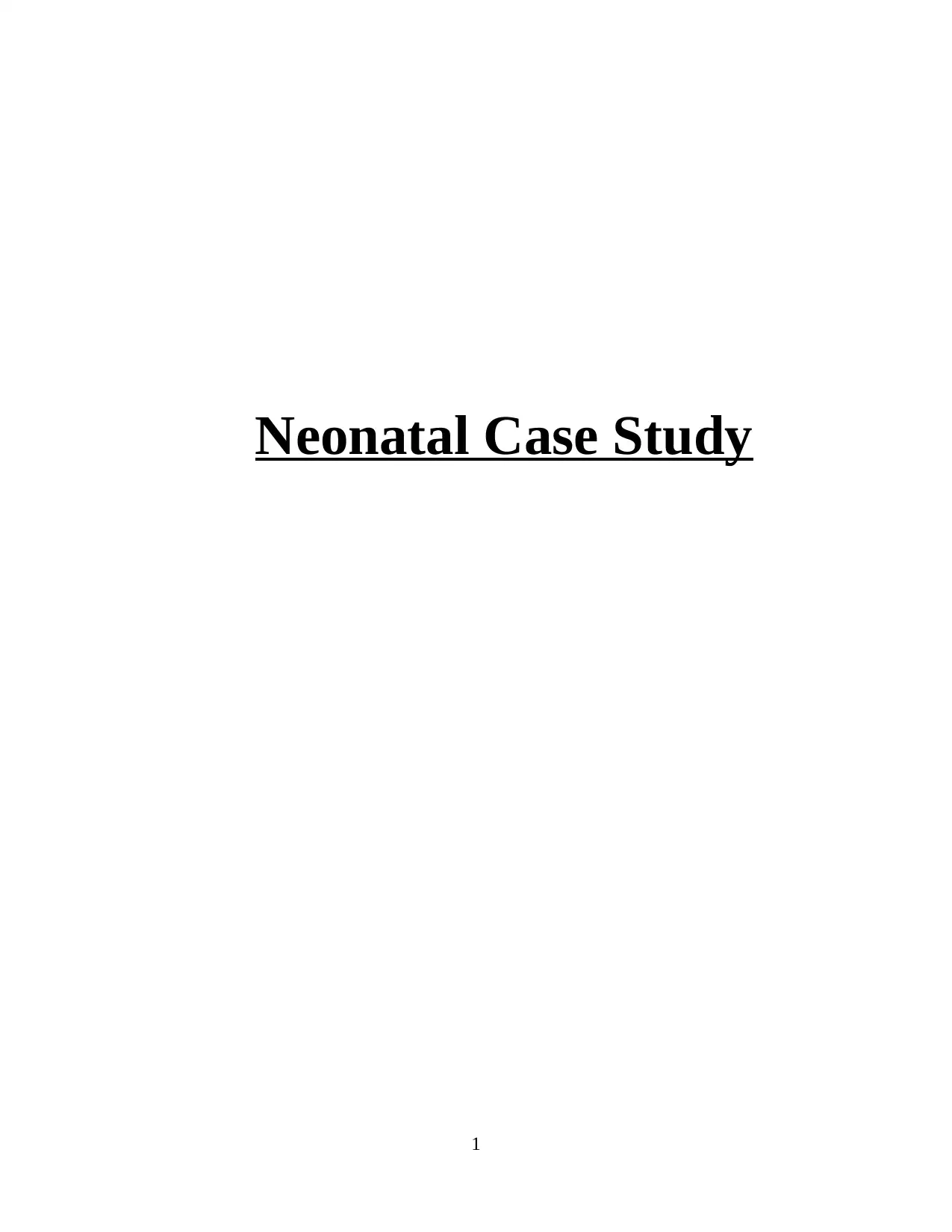
Neonatal Case Study
1
1
Paraphrase This Document
Need a fresh take? Get an instant paraphrase of this document with our AI Paraphraser

Contents
INTRODUCTION...........................................................................................................................3
MAIN BODY...................................................................................................................................3
Pathophysiology of Neonatal Respiratory Distress Syndrome..............................................3
Treatment and nursing/ midwifery management of the clinical problem (Neonatal Respiratory
Distress Syndrome)................................................................................................................4
Assessment data......................................................................................................................5
Principles of family centred care in relation to the family of Jack.........................................5
CONCLUSION................................................................................................................................6
REFERENCES................................................................................................................................7
2
INTRODUCTION...........................................................................................................................3
MAIN BODY...................................................................................................................................3
Pathophysiology of Neonatal Respiratory Distress Syndrome..............................................3
Treatment and nursing/ midwifery management of the clinical problem (Neonatal Respiratory
Distress Syndrome)................................................................................................................4
Assessment data......................................................................................................................5
Principles of family centred care in relation to the family of Jack.........................................5
CONCLUSION................................................................................................................................6
REFERENCES................................................................................................................................7
2
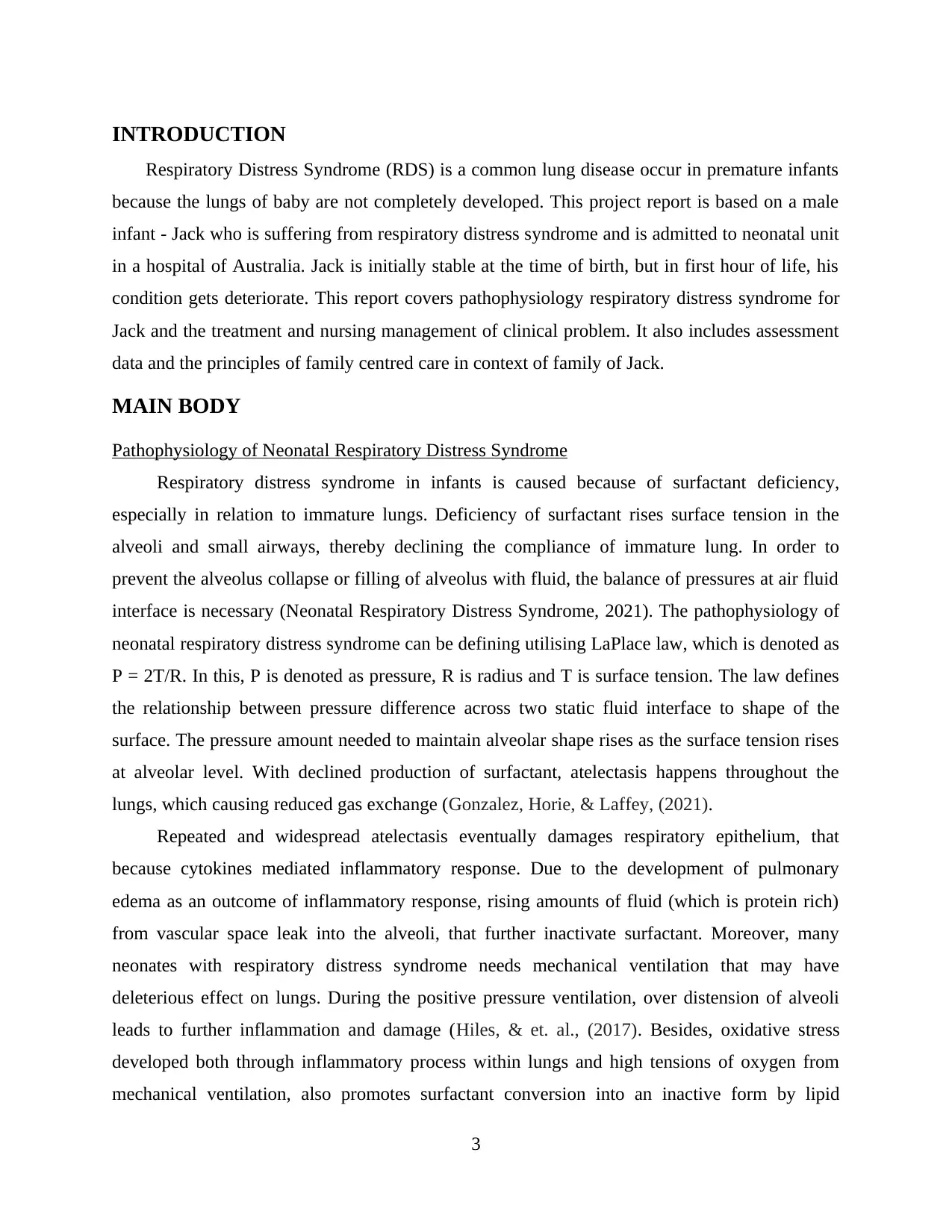
INTRODUCTION
Respiratory Distress Syndrome (RDS) is a common lung disease occur in premature infants
because the lungs of baby are not completely developed. This project report is based on a male
infant - Jack who is suffering from respiratory distress syndrome and is admitted to neonatal unit
in a hospital of Australia. Jack is initially stable at the time of birth, but in first hour of life, his
condition gets deteriorate. This report covers pathophysiology respiratory distress syndrome for
Jack and the treatment and nursing management of clinical problem. It also includes assessment
data and the principles of family centred care in context of family of Jack.
MAIN BODY
Pathophysiology of Neonatal Respiratory Distress Syndrome
Respiratory distress syndrome in infants is caused because of surfactant deficiency,
especially in relation to immature lungs. Deficiency of surfactant rises surface tension in the
alveoli and small airways, thereby declining the compliance of immature lung. In order to
prevent the alveolus collapse or filling of alveolus with fluid, the balance of pressures at air fluid
interface is necessary (Neonatal Respiratory Distress Syndrome, 2021). The pathophysiology of
neonatal respiratory distress syndrome can be defining utilising LaPlace law, which is denoted as
P = 2T/R. In this, P is denoted as pressure, R is radius and T is surface tension. The law defines
the relationship between pressure difference across two static fluid interface to shape of the
surface. The pressure amount needed to maintain alveolar shape rises as the surface tension rises
at alveolar level. With declined production of surfactant, atelectasis happens throughout the
lungs, which causing reduced gas exchange (Gonzalez, Horie, & Laffey, (2021).
Repeated and widespread atelectasis eventually damages respiratory epithelium, that
because cytokines mediated inflammatory response. Due to the development of pulmonary
edema as an outcome of inflammatory response, rising amounts of fluid (which is protein rich)
from vascular space leak into the alveoli, that further inactivate surfactant. Moreover, many
neonates with respiratory distress syndrome needs mechanical ventilation that may have
deleterious effect on lungs. During the positive pressure ventilation, over distension of alveoli
leads to further inflammation and damage (Hiles, & et. al., (2017). Besides, oxidative stress
developed both through inflammatory process within lungs and high tensions of oxygen from
mechanical ventilation, also promotes surfactant conversion into an inactive form by lipid
3
Respiratory Distress Syndrome (RDS) is a common lung disease occur in premature infants
because the lungs of baby are not completely developed. This project report is based on a male
infant - Jack who is suffering from respiratory distress syndrome and is admitted to neonatal unit
in a hospital of Australia. Jack is initially stable at the time of birth, but in first hour of life, his
condition gets deteriorate. This report covers pathophysiology respiratory distress syndrome for
Jack and the treatment and nursing management of clinical problem. It also includes assessment
data and the principles of family centred care in context of family of Jack.
MAIN BODY
Pathophysiology of Neonatal Respiratory Distress Syndrome
Respiratory distress syndrome in infants is caused because of surfactant deficiency,
especially in relation to immature lungs. Deficiency of surfactant rises surface tension in the
alveoli and small airways, thereby declining the compliance of immature lung. In order to
prevent the alveolus collapse or filling of alveolus with fluid, the balance of pressures at air fluid
interface is necessary (Neonatal Respiratory Distress Syndrome, 2021). The pathophysiology of
neonatal respiratory distress syndrome can be defining utilising LaPlace law, which is denoted as
P = 2T/R. In this, P is denoted as pressure, R is radius and T is surface tension. The law defines
the relationship between pressure difference across two static fluid interface to shape of the
surface. The pressure amount needed to maintain alveolar shape rises as the surface tension rises
at alveolar level. With declined production of surfactant, atelectasis happens throughout the
lungs, which causing reduced gas exchange (Gonzalez, Horie, & Laffey, (2021).
Repeated and widespread atelectasis eventually damages respiratory epithelium, that
because cytokines mediated inflammatory response. Due to the development of pulmonary
edema as an outcome of inflammatory response, rising amounts of fluid (which is protein rich)
from vascular space leak into the alveoli, that further inactivate surfactant. Moreover, many
neonates with respiratory distress syndrome needs mechanical ventilation that may have
deleterious effect on lungs. During the positive pressure ventilation, over distension of alveoli
leads to further inflammation and damage (Hiles, & et. al., (2017). Besides, oxidative stress
developed both through inflammatory process within lungs and high tensions of oxygen from
mechanical ventilation, also promotes surfactant conversion into an inactive form by lipid
3
⊘ This is a preview!⊘
Do you want full access?
Subscribe today to unlock all pages.

Trusted by 1+ million students worldwide
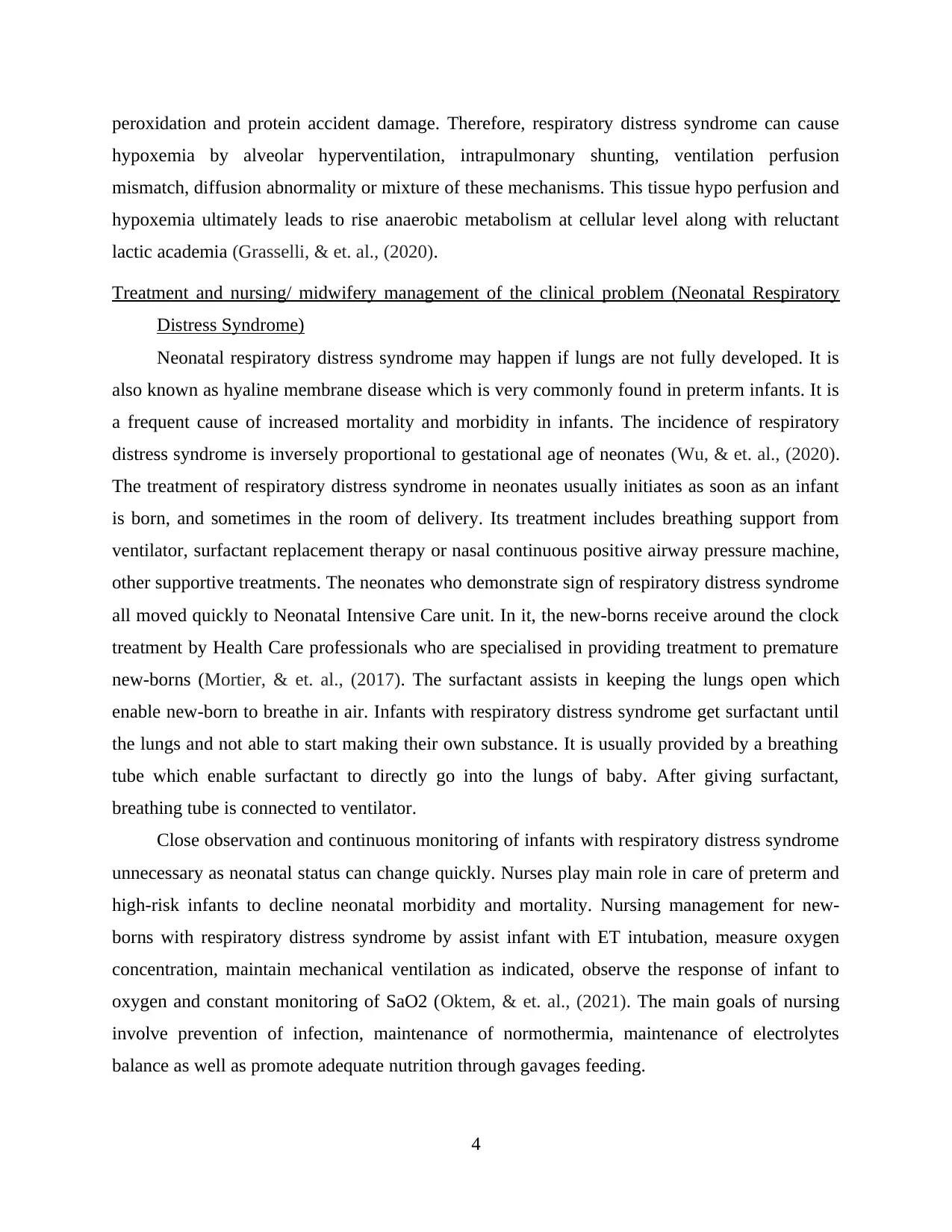
peroxidation and protein accident damage. Therefore, respiratory distress syndrome can cause
hypoxemia by alveolar hyperventilation, intrapulmonary shunting, ventilation perfusion
mismatch, diffusion abnormality or mixture of these mechanisms. This tissue hypo perfusion and
hypoxemia ultimately leads to rise anaerobic metabolism at cellular level along with reluctant
lactic academia (Grasselli, & et. al., (2020).
Treatment and nursing/ midwifery management of the clinical problem (Neonatal Respiratory
Distress Syndrome)
Neonatal respiratory distress syndrome may happen if lungs are not fully developed. It is
also known as hyaline membrane disease which is very commonly found in preterm infants. It is
a frequent cause of increased mortality and morbidity in infants. The incidence of respiratory
distress syndrome is inversely proportional to gestational age of neonates (Wu, & et. al., (2020).
The treatment of respiratory distress syndrome in neonates usually initiates as soon as an infant
is born, and sometimes in the room of delivery. Its treatment includes breathing support from
ventilator, surfactant replacement therapy or nasal continuous positive airway pressure machine,
other supportive treatments. The neonates who demonstrate sign of respiratory distress syndrome
all moved quickly to Neonatal Intensive Care unit. In it, the new-borns receive around the clock
treatment by Health Care professionals who are specialised in providing treatment to premature
new-borns (Mortier, & et. al., (2017). The surfactant assists in keeping the lungs open which
enable new-born to breathe in air. Infants with respiratory distress syndrome get surfactant until
the lungs and not able to start making their own substance. It is usually provided by a breathing
tube which enable surfactant to directly go into the lungs of baby. After giving surfactant,
breathing tube is connected to ventilator.
Close observation and continuous monitoring of infants with respiratory distress syndrome
unnecessary as neonatal status can change quickly. Nurses play main role in care of preterm and
high-risk infants to decline neonatal morbidity and mortality. Nursing management for new-
borns with respiratory distress syndrome by assist infant with ET intubation, measure oxygen
concentration, maintain mechanical ventilation as indicated, observe the response of infant to
oxygen and constant monitoring of SaO2 (Oktem, & et. al., (2021). The main goals of nursing
involve prevention of infection, maintenance of normothermia, maintenance of electrolytes
balance as well as promote adequate nutrition through gavages feeding.
4
hypoxemia by alveolar hyperventilation, intrapulmonary shunting, ventilation perfusion
mismatch, diffusion abnormality or mixture of these mechanisms. This tissue hypo perfusion and
hypoxemia ultimately leads to rise anaerobic metabolism at cellular level along with reluctant
lactic academia (Grasselli, & et. al., (2020).
Treatment and nursing/ midwifery management of the clinical problem (Neonatal Respiratory
Distress Syndrome)
Neonatal respiratory distress syndrome may happen if lungs are not fully developed. It is
also known as hyaline membrane disease which is very commonly found in preterm infants. It is
a frequent cause of increased mortality and morbidity in infants. The incidence of respiratory
distress syndrome is inversely proportional to gestational age of neonates (Wu, & et. al., (2020).
The treatment of respiratory distress syndrome in neonates usually initiates as soon as an infant
is born, and sometimes in the room of delivery. Its treatment includes breathing support from
ventilator, surfactant replacement therapy or nasal continuous positive airway pressure machine,
other supportive treatments. The neonates who demonstrate sign of respiratory distress syndrome
all moved quickly to Neonatal Intensive Care unit. In it, the new-borns receive around the clock
treatment by Health Care professionals who are specialised in providing treatment to premature
new-borns (Mortier, & et. al., (2017). The surfactant assists in keeping the lungs open which
enable new-born to breathe in air. Infants with respiratory distress syndrome get surfactant until
the lungs and not able to start making their own substance. It is usually provided by a breathing
tube which enable surfactant to directly go into the lungs of baby. After giving surfactant,
breathing tube is connected to ventilator.
Close observation and continuous monitoring of infants with respiratory distress syndrome
unnecessary as neonatal status can change quickly. Nurses play main role in care of preterm and
high-risk infants to decline neonatal morbidity and mortality. Nursing management for new-
borns with respiratory distress syndrome by assist infant with ET intubation, measure oxygen
concentration, maintain mechanical ventilation as indicated, observe the response of infant to
oxygen and constant monitoring of SaO2 (Oktem, & et. al., (2021). The main goals of nursing
involve prevention of infection, maintenance of normothermia, maintenance of electrolytes
balance as well as promote adequate nutrition through gavages feeding.
4
Paraphrase This Document
Need a fresh take? Get an instant paraphrase of this document with our AI Paraphraser

Assessment data
According to the provided case study, Jack is a male infant admitted in a tertiary hospital
in Australia. He was assessed by nursing staff on admission and is initially stable. However, in
the initial hour of life, he begins to deteriorate. He has grunting respirations and his SpO2 level
constantly decreases to 86%. His heart rate was 146 and birth weight was 1620 gram. His
mucous membranes also get pink and has heel prick blood gas. Jack was diagnosed with
respiratory distress syndrome by the care professionals (De Bisschop, Derriks, & Cools, (2020).
The signs of respiratory distress syndrome in case of Jack appears immediately after one hour of
his birth. It is characterized through tachypnea (>60 breathes / min.), Nasal flaring, cyanosis in
room air, subcostal and intercostal retractions and grunting. In the assessment of Jack, it has been
found that he has grunting respirations and sub sternal recession. Granting outcomes from partial
closure of glottis at the time of forced expiration in an effort of maintaining FRC (Pang, & et. al.,
(2019). The retractions happen as the new born is forced to develop high intrathoracic pressure in
order to expand the poorly compliant lungs. After initial improvement with stabilization and
resuscitation, an uncomplicated course is characterized through progressive worsening 48 hours
to 72 hours. The recovery can coincide usually with diuresis after starting period of oliguria.
Acidosis, hypotension and hyperkalaemia may be the other clinical features. A chest radiograph
demonstrates low volume of lungs and bilateral reticular granular pattern with superimposed air
bronchograms. Complete white out of lung fields show in the most severe cases. Positive airway
pressure application may reduce or even eliminate radiographic findings. Acute complications
involve intracranial haemorrhage and air leaks. Long term, respiratory distress syndrome has
been related to a rising incidence of ROP, chronic lung disease and neurological impairment
(Rizzo, & Schmidt, (2021).
Principles of family centred care in relation to the family of Jack
Respiratory distress syndrome happens because of non-development of lungs. The more
premature a baby is, the most possibly it is for the infant to have respiratory distress syndrome. It
is caused due to not having enough surfactant in lungs (Büke, & et. al., (2019). Surfactant is a
kind of substance which allows lungs to contract and expand. It keeps small sacs of air in lungs
called alveoli, open (Condò, & et. al., (2017). The main symptoms of disease include flaring of
nostrils, grunting while breathing, bluish tint to skin, rapid or shallow breathing and reduced
children output. It can be diagnosed through lab test and chest X Ray in order to examine lungs
5
According to the provided case study, Jack is a male infant admitted in a tertiary hospital
in Australia. He was assessed by nursing staff on admission and is initially stable. However, in
the initial hour of life, he begins to deteriorate. He has grunting respirations and his SpO2 level
constantly decreases to 86%. His heart rate was 146 and birth weight was 1620 gram. His
mucous membranes also get pink and has heel prick blood gas. Jack was diagnosed with
respiratory distress syndrome by the care professionals (De Bisschop, Derriks, & Cools, (2020).
The signs of respiratory distress syndrome in case of Jack appears immediately after one hour of
his birth. It is characterized through tachypnea (>60 breathes / min.), Nasal flaring, cyanosis in
room air, subcostal and intercostal retractions and grunting. In the assessment of Jack, it has been
found that he has grunting respirations and sub sternal recession. Granting outcomes from partial
closure of glottis at the time of forced expiration in an effort of maintaining FRC (Pang, & et. al.,
(2019). The retractions happen as the new born is forced to develop high intrathoracic pressure in
order to expand the poorly compliant lungs. After initial improvement with stabilization and
resuscitation, an uncomplicated course is characterized through progressive worsening 48 hours
to 72 hours. The recovery can coincide usually with diuresis after starting period of oliguria.
Acidosis, hypotension and hyperkalaemia may be the other clinical features. A chest radiograph
demonstrates low volume of lungs and bilateral reticular granular pattern with superimposed air
bronchograms. Complete white out of lung fields show in the most severe cases. Positive airway
pressure application may reduce or even eliminate radiographic findings. Acute complications
involve intracranial haemorrhage and air leaks. Long term, respiratory distress syndrome has
been related to a rising incidence of ROP, chronic lung disease and neurological impairment
(Rizzo, & Schmidt, (2021).
Principles of family centred care in relation to the family of Jack
Respiratory distress syndrome happens because of non-development of lungs. The more
premature a baby is, the most possibly it is for the infant to have respiratory distress syndrome. It
is caused due to not having enough surfactant in lungs (Büke, & et. al., (2019). Surfactant is a
kind of substance which allows lungs to contract and expand. It keeps small sacs of air in lungs
called alveoli, open (Condò, & et. al., (2017). The main symptoms of disease include flaring of
nostrils, grunting while breathing, bluish tint to skin, rapid or shallow breathing and reduced
children output. It can be diagnosed through lab test and chest X Ray in order to examine lungs
5
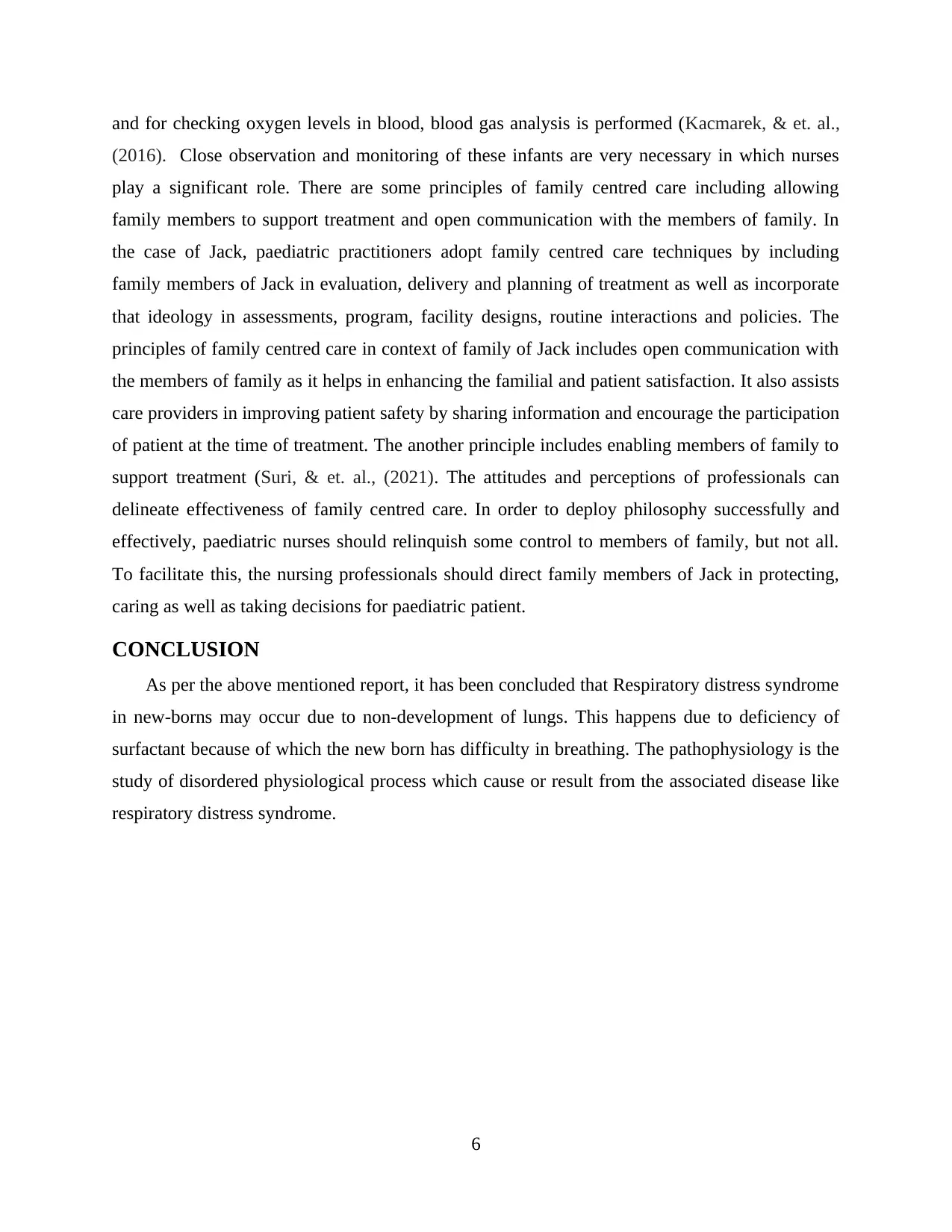
and for checking oxygen levels in blood, blood gas analysis is performed (Kacmarek, & et. al.,
(2016). Close observation and monitoring of these infants are very necessary in which nurses
play a significant role. There are some principles of family centred care including allowing
family members to support treatment and open communication with the members of family. In
the case of Jack, paediatric practitioners adopt family centred care techniques by including
family members of Jack in evaluation, delivery and planning of treatment as well as incorporate
that ideology in assessments, program, facility designs, routine interactions and policies. The
principles of family centred care in context of family of Jack includes open communication with
the members of family as it helps in enhancing the familial and patient satisfaction. It also assists
care providers in improving patient safety by sharing information and encourage the participation
of patient at the time of treatment. The another principle includes enabling members of family to
support treatment (Suri, & et. al., (2021). The attitudes and perceptions of professionals can
delineate effectiveness of family centred care. In order to deploy philosophy successfully and
effectively, paediatric nurses should relinquish some control to members of family, but not all.
To facilitate this, the nursing professionals should direct family members of Jack in protecting,
caring as well as taking decisions for paediatric patient.
CONCLUSION
As per the above mentioned report, it has been concluded that Respiratory distress syndrome
in new-borns may occur due to non-development of lungs. This happens due to deficiency of
surfactant because of which the new born has difficulty in breathing. The pathophysiology is the
study of disordered physiological process which cause or result from the associated disease like
respiratory distress syndrome.
6
(2016). Close observation and monitoring of these infants are very necessary in which nurses
play a significant role. There are some principles of family centred care including allowing
family members to support treatment and open communication with the members of family. In
the case of Jack, paediatric practitioners adopt family centred care techniques by including
family members of Jack in evaluation, delivery and planning of treatment as well as incorporate
that ideology in assessments, program, facility designs, routine interactions and policies. The
principles of family centred care in context of family of Jack includes open communication with
the members of family as it helps in enhancing the familial and patient satisfaction. It also assists
care providers in improving patient safety by sharing information and encourage the participation
of patient at the time of treatment. The another principle includes enabling members of family to
support treatment (Suri, & et. al., (2021). The attitudes and perceptions of professionals can
delineate effectiveness of family centred care. In order to deploy philosophy successfully and
effectively, paediatric nurses should relinquish some control to members of family, but not all.
To facilitate this, the nursing professionals should direct family members of Jack in protecting,
caring as well as taking decisions for paediatric patient.
CONCLUSION
As per the above mentioned report, it has been concluded that Respiratory distress syndrome
in new-borns may occur due to non-development of lungs. This happens due to deficiency of
surfactant because of which the new born has difficulty in breathing. The pathophysiology is the
study of disordered physiological process which cause or result from the associated disease like
respiratory distress syndrome.
6
⊘ This is a preview!⊘
Do you want full access?
Subscribe today to unlock all pages.

Trusted by 1+ million students worldwide
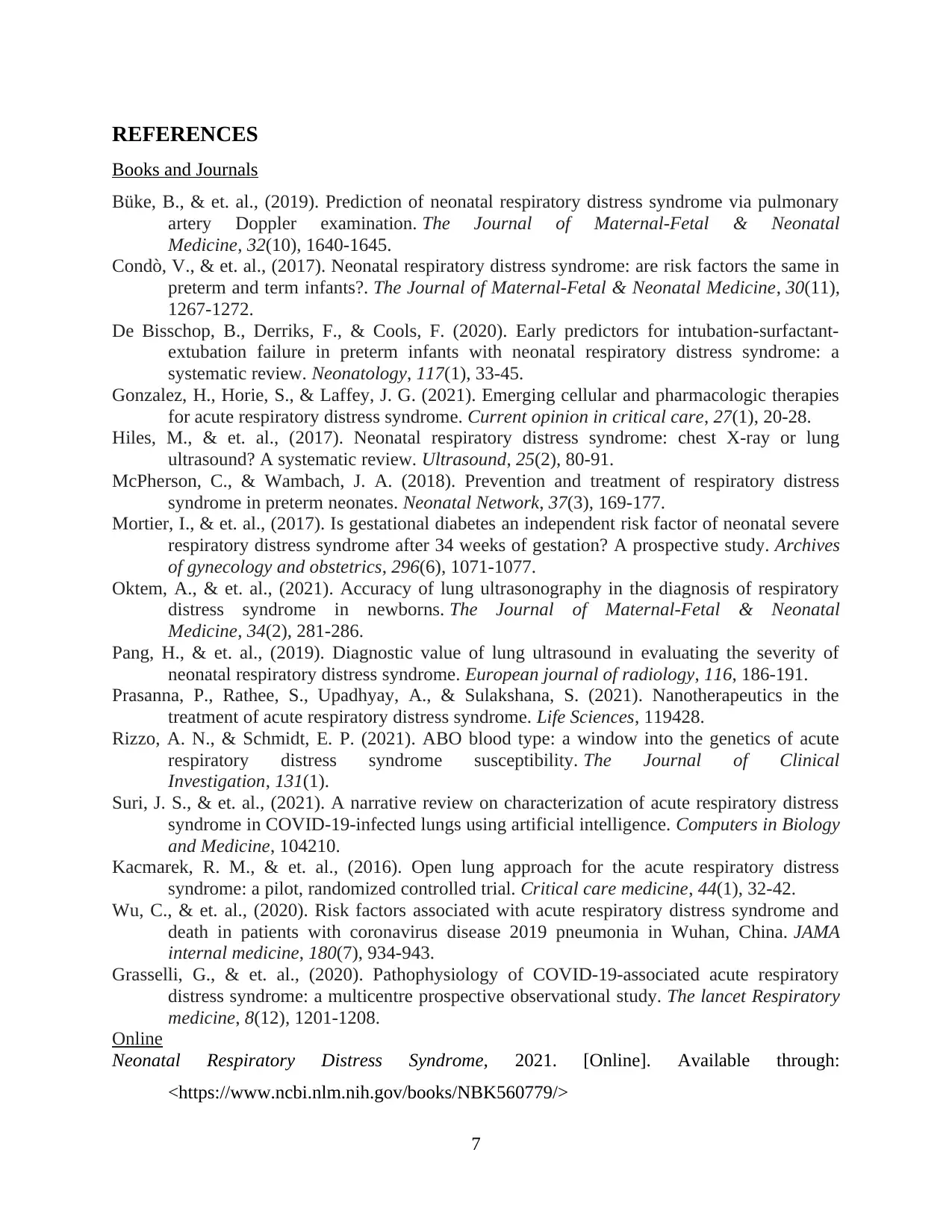
REFERENCES
Books and Journals
Büke, B., & et. al., (2019). Prediction of neonatal respiratory distress syndrome via pulmonary
artery Doppler examination. The Journal of Maternal-Fetal & Neonatal
Medicine, 32(10), 1640-1645.
Condò, V., & et. al., (2017). Neonatal respiratory distress syndrome: are risk factors the same in
preterm and term infants?. The Journal of Maternal-Fetal & Neonatal Medicine, 30(11),
1267-1272.
De Bisschop, B., Derriks, F., & Cools, F. (2020). Early predictors for intubation-surfactant-
extubation failure in preterm infants with neonatal respiratory distress syndrome: a
systematic review. Neonatology, 117(1), 33-45.
Gonzalez, H., Horie, S., & Laffey, J. G. (2021). Emerging cellular and pharmacologic therapies
for acute respiratory distress syndrome. Current opinion in critical care, 27(1), 20-28.
Hiles, M., & et. al., (2017). Neonatal respiratory distress syndrome: chest X-ray or lung
ultrasound? A systematic review. Ultrasound, 25(2), 80-91.
McPherson, C., & Wambach, J. A. (2018). Prevention and treatment of respiratory distress
syndrome in preterm neonates. Neonatal Network, 37(3), 169-177.
Mortier, I., & et. al., (2017). Is gestational diabetes an independent risk factor of neonatal severe
respiratory distress syndrome after 34 weeks of gestation? A prospective study. Archives
of gynecology and obstetrics, 296(6), 1071-1077.
Oktem, A., & et. al., (2021). Accuracy of lung ultrasonography in the diagnosis of respiratory
distress syndrome in newborns. The Journal of Maternal-Fetal & Neonatal
Medicine, 34(2), 281-286.
Pang, H., & et. al., (2019). Diagnostic value of lung ultrasound in evaluating the severity of
neonatal respiratory distress syndrome. European journal of radiology, 116, 186-191.
Prasanna, P., Rathee, S., Upadhyay, A., & Sulakshana, S. (2021). Nanotherapeutics in the
treatment of acute respiratory distress syndrome. Life Sciences, 119428.
Rizzo, A. N., & Schmidt, E. P. (2021). ABO blood type: a window into the genetics of acute
respiratory distress syndrome susceptibility. The Journal of Clinical
Investigation, 131(1).
Suri, J. S., & et. al., (2021). A narrative review on characterization of acute respiratory distress
syndrome in COVID-19-infected lungs using artificial intelligence. Computers in Biology
and Medicine, 104210.
Kacmarek, R. M., & et. al., (2016). Open lung approach for the acute respiratory distress
syndrome: a pilot, randomized controlled trial. Critical care medicine, 44(1), 32-42.
Wu, C., & et. al., (2020). Risk factors associated with acute respiratory distress syndrome and
death in patients with coronavirus disease 2019 pneumonia in Wuhan, China. JAMA
internal medicine, 180(7), 934-943.
Grasselli, G., & et. al., (2020). Pathophysiology of COVID-19-associated acute respiratory
distress syndrome: a multicentre prospective observational study. The lancet Respiratory
medicine, 8(12), 1201-1208.
Online
Neonatal Respiratory Distress Syndrome, 2021. [Online]. Available through:
<https://www.ncbi.nlm.nih.gov/books/NBK560779/>
7
Books and Journals
Büke, B., & et. al., (2019). Prediction of neonatal respiratory distress syndrome via pulmonary
artery Doppler examination. The Journal of Maternal-Fetal & Neonatal
Medicine, 32(10), 1640-1645.
Condò, V., & et. al., (2017). Neonatal respiratory distress syndrome: are risk factors the same in
preterm and term infants?. The Journal of Maternal-Fetal & Neonatal Medicine, 30(11),
1267-1272.
De Bisschop, B., Derriks, F., & Cools, F. (2020). Early predictors for intubation-surfactant-
extubation failure in preterm infants with neonatal respiratory distress syndrome: a
systematic review. Neonatology, 117(1), 33-45.
Gonzalez, H., Horie, S., & Laffey, J. G. (2021). Emerging cellular and pharmacologic therapies
for acute respiratory distress syndrome. Current opinion in critical care, 27(1), 20-28.
Hiles, M., & et. al., (2017). Neonatal respiratory distress syndrome: chest X-ray or lung
ultrasound? A systematic review. Ultrasound, 25(2), 80-91.
McPherson, C., & Wambach, J. A. (2018). Prevention and treatment of respiratory distress
syndrome in preterm neonates. Neonatal Network, 37(3), 169-177.
Mortier, I., & et. al., (2017). Is gestational diabetes an independent risk factor of neonatal severe
respiratory distress syndrome after 34 weeks of gestation? A prospective study. Archives
of gynecology and obstetrics, 296(6), 1071-1077.
Oktem, A., & et. al., (2021). Accuracy of lung ultrasonography in the diagnosis of respiratory
distress syndrome in newborns. The Journal of Maternal-Fetal & Neonatal
Medicine, 34(2), 281-286.
Pang, H., & et. al., (2019). Diagnostic value of lung ultrasound in evaluating the severity of
neonatal respiratory distress syndrome. European journal of radiology, 116, 186-191.
Prasanna, P., Rathee, S., Upadhyay, A., & Sulakshana, S. (2021). Nanotherapeutics in the
treatment of acute respiratory distress syndrome. Life Sciences, 119428.
Rizzo, A. N., & Schmidt, E. P. (2021). ABO blood type: a window into the genetics of acute
respiratory distress syndrome susceptibility. The Journal of Clinical
Investigation, 131(1).
Suri, J. S., & et. al., (2021). A narrative review on characterization of acute respiratory distress
syndrome in COVID-19-infected lungs using artificial intelligence. Computers in Biology
and Medicine, 104210.
Kacmarek, R. M., & et. al., (2016). Open lung approach for the acute respiratory distress
syndrome: a pilot, randomized controlled trial. Critical care medicine, 44(1), 32-42.
Wu, C., & et. al., (2020). Risk factors associated with acute respiratory distress syndrome and
death in patients with coronavirus disease 2019 pneumonia in Wuhan, China. JAMA
internal medicine, 180(7), 934-943.
Grasselli, G., & et. al., (2020). Pathophysiology of COVID-19-associated acute respiratory
distress syndrome: a multicentre prospective observational study. The lancet Respiratory
medicine, 8(12), 1201-1208.
Online
Neonatal Respiratory Distress Syndrome, 2021. [Online]. Available through:
<https://www.ncbi.nlm.nih.gov/books/NBK560779/>
7
1 out of 7
Your All-in-One AI-Powered Toolkit for Academic Success.
+13062052269
info@desklib.com
Available 24*7 on WhatsApp / Email
![[object Object]](/_next/static/media/star-bottom.7253800d.svg)
Unlock your academic potential
Copyright © 2020–2025 A2Z Services. All Rights Reserved. Developed and managed by ZUCOL.


